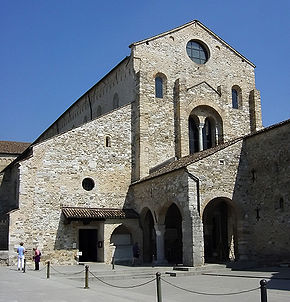Aquileia
| Aquileia | ||
|---|---|---|
| Comune | ||
| Comune di Aquileia | ||

The Basilica of Aquileia.
|
||
|
||
| Location of Aquileia in Italy | ||
| Coordinates: 45°46′11.01″N 13°22′16.29″E / 45.7697250°N 13.3711917°ECoordinates: 45°46′11.01″N 13°22′16.29″E / 45.7697250°N 13.3711917°E | ||
| Country | Italy | |
| Region | Friuli-Venezia Giulia | |
| Province / Metropolitan city | Udine (UD) | |
| Frazioni | Beligna, Belvedere, Viola, Monastero | |
| Government | ||
| • Mayor | Gabriele Spanghero (since May 2014) | |
| Area | ||
| • Total | 36 km2 (14 sq mi) | |
| Elevation | 5 m (16 ft) | |
| Population (30 June 2009) | ||
| • Total | 3,503 | |
| • Density | 97/km2 (250/sq mi) | |
| Demonym(s) | Aquileiesi | |
| Time zone | CET (UTC+1) | |
| • Summer (DST) | CEST (UTC+2) | |
| Postal code | 33051 | |
| Dialing code | 0431 | |
| Patron saint | Sts. Hermagoras and Fortunatus | |
| Saint day | July 12 | |
| Website | Official website | |
| Archaeological Area and the Patriarchal Basilica of Aquileia | |
|---|---|
| Name as inscribed on the World Heritage List | |
 |
|
| Location | Italy |
| Type | Cultural |
| Criteria | iii, iv, vi |
| Reference | 825 |
| UNESCO region | Europe and North America |
| Inscription history | |
| Inscription | 1998 (22nd Session) |
Aquileia (/ˌækwɪˈliːə/; Italian: [akwiˈlɛːja]; Friulian: Acuilee/Aquilee/Aquilea,Venetian: Aquiłeja/Aquiłegia, German: Aglar, Slovene: Oglej) is an ancient Roman city in Italy, at the head of the Adriatic at the edge of the lagoons, about 10 kilometres (6 mi) from the sea, on the river Natiso (modern Natisone), the course of which has changed somewhat since Roman times. Today, the city is small (about 3,500 inhabitants), but it was large and prominent in Antiquity as one of the world's largest cities with a population of 100,000 in the 2nd century AD. and is one of the main archeological sites of Northern Italy.
Aquileia was founded as a colony by the Romans in 180/181 BC along the Natiso River, on land south of the Julian Alps but about 13 kilometres (8 mi) north of the lagoons. Presumably named from the probably Celtic word Akylis, the colony served as a strategic frontier fortress at the north-east corner of transpadane (on the far side of the Po river) Italy and was intended to protect the Veneti, faithful allies of Rome during the invasion of Hannibal and the Illyrian Wars. The colony would serve as a citadel to check the advance into Cisalpine Gaul of other warlike peoples, such as the hostile Carni to the northeast in what is now Carnia and Histri tribes to the southeast in what is now Istria. In fact, the site chosen for Aquileia was about 6 km from where an estimated 12,000 Celtic Taurisci nomads had attempted to settle in 183 BC. However, since the 13th century BC, the site, on the river and at the head of the Adriatic, had also been of commercial importance as the end of the Baltic amber (sucinum) trade. It is, therefore, theoretically not unlikely that Aquileia had been a Gallic oppidum even before the coming of the Romans. However, few Celtic artifacts have been discovered from 500 BC to the Roman arrival.
...
Wikipedia


